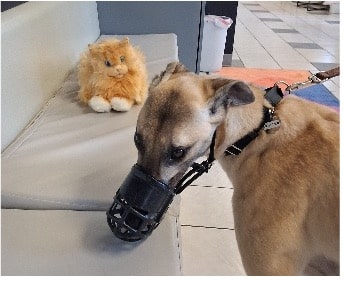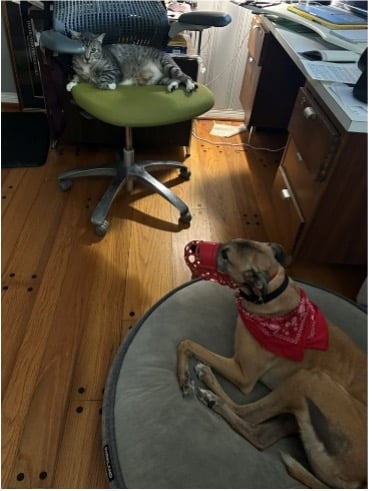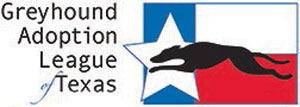By Katy Cassidy
Did you ever wonder just how GALT ensures a greyhound is kitty friendly?
We begin with a fairly simple 4-phase process after we do an introductory test with Cheezits, our Medi-cat (aka “robo-kitty”). If the hound doesn’t try to attack the animated cat, we proceed to very controlled testing with live cats.
- Muzzle & Leash. We get an initial reaction of the dog to the cat(s). Some don’t make it past stage 1. Intense alertness and gaze at the cat, pulling, clop of the teeth, coming back to the same location where they saw the cat before after you’ve moved on…buh-bye.
Note* Occasionally, we have an enthusiastic hound that comes on like gangbusters. They may just need some time to settle down. Cat is interesting, this thing is interesting, the next thing is interesting, on-and on. If mild or little interest, move on to next step - On-leash, Muzzle off. With or without muzzle (preferably with, if our handlers are comfortable) sometimes a good sniff of the cat is all the dog needs to decide “no big deal” and move on to the next curiosity. We keep a tight leash during this step, though.
- Muzzle on, Leash off. We watch very closely. Some cats are more active than others while some try not to draw attention to themselves. Laser toys, dangly toys can make the cat more interesting.
- Muzzle off, Leash off. We only do this if we’re comfortable enough after long observation at step 3. The hound can change its chill at any of these stages. If the hound is cool with the cats, it’s passed the initial cat test and is ready for Kitty Boot Camp (KBC) at a skilled foster homes with one or more felines.
GALT understands that not all cats are created equally. Also, indoor cats can be friends and if they step outside the door, the attitude can change in an instant. Making sure a hound is friendly around cats is a process and may take several weeks or months. The safety of our foster family’s cat, and the prospective adopter’s cat, is our top priority. Once you see what GALT does, you will understand why finding a cat tolerant dog takes time.
This is how one of our experienced KBC fosters prepares for a new arrival, as told by Katy Cassidy.
When I get ready for an incoming KBC hound, I remember two things – it’s not a race and my own pets come first. I have had hounds arrive already bored of cats, and I have had some take longer to adjust. There are no prizes for leaving KBC early, so don’t rush or push it. The prize is the text from their new home saying how great they are with the cats.
Before the hound arrives, I set up my house with spaces and obstacles – the crate and gates already up and cat-only zones set. The hound might not need a crate at their new home, but having a crate is a must for my KBC. Nighttime cat shenanigans might trigger a hound and the time it takes for you to wake up and deal with this is time no one has. Having a crate is also helpful when you know the hound won’t stay in KBC and needs to be picked up. Crates are a must.
Gates and door straps make good obstacles. I install the gates at a tilt so that the cats don’t need to jump to get to the other side. Door straps are good for the curious and playful hound, but not for one that might be failing (ahem, see “crate”). While the hound is getting used to my place, I take time to close doors to give everyone (especially me) a break. Sometimes I close my cats in my bedroom and sometimes the cats are free to roam, and the hounds are in my office. Since this is new to everyone, giving some complete separation is a necessary break for all involved.

Another obstacle is the one the hound wears – a muzzle. Do not fear the muzzle. Is it uncomfortable? Probably, and it’s entirely necessary. Children inthe 80s survived sleeping with headgear, my camper can handle a muzzle. Even a hound that I feel will pass might want to nip. I know they don’t necessarily have prey drive at this time, but what about “play drive”? The muzzle allows the hound to get closer and have the sniff. Keeping a hound on a lead and a muzzle on the hound at the beginning gives everyone a chance. My latest loved the muzzle because she knew that when the muzzle came out, the cats would be released. Hounds are curious and just because they want to get close doesn’t mean the cat is now lunch. Scent is important and the muzzle gives us this opportunity to be close without being in danger.
The last thing I would emphasize is communication. I pay attention to my cats’ body language. As I get to know the foster and learn their mannerisms, I communicate with the Adoption Coordinator and the applicant. I usually set up a folder on DropBox or my Photos app to share. I take videos that show what I’m working on can be large, so a drive or folder to share is helpful.
And most importantly, after adoption – communicate with GALT. If you have questions or feel it’s not a good fit, let someone know. Some will fail KBC totally, and some might need a different space—not a better space, just a different space.
You will notice that we refer to a dog as, “cat friendly” or “cat tolerant” and not “cat safe”. It’s incumbent upon all of us to ensure every pet in the house feels comfortable with one another.
